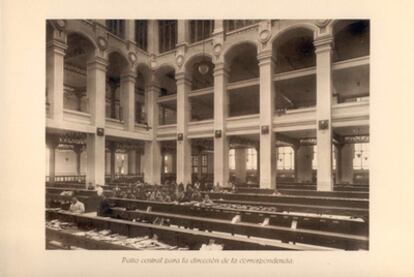A case of post-modern architecture
How the old Palacio de Comunicaciones became Madrid's high-tech City Hall
One cardboard box and one water-filled condom. They are the tools the architects at Estudio Arquimática used to build the first scale model of the high-tech-looking dome that covers the former coach house at the landmark Palacio de Comunicaciones building on Plaza de Cibeles. They cut the floor plan out of the box cover (the site is shaped like a gun) and used it to enclose the prophylactic, which they had previously filled with water. Pressure did the rest: the part of the condom sticking out of the opening afforded a preview of what the glass dome would eventually look like.
"Later we transferred the design to a computer and made all the relevant calculations and 3D recreations," says Arquimática director Francisco Partearroyo. As he speaks, 20 meters above him four men walk around on the glass dome, cleaning it with mops. It certainly appears to be steady.
As he speaks, four men walk around on the glass dome 20 meters above him
"The 1904 architects used a conventional skin, but the inside was very advanced"
A century before the box-and-condom scene, another architect who was barely out of school made a cast model of this monumental construction. Antonio Palacios and his partner Joaquín Otamendi were 30 years old in 1904, when they won the public tender to build the Postal and Telegraph House.
"On the outside, they used a conventional decorative skin, but on the inside they designed a very advanced structure," says Partearroyo.
Under its cake-like appearance, the overelaborate building (a blend of Neo-Plateresque, Modernist, Art Déco and Vienna Secession styles) conceals a functional, avant-garde structure that the recent reform sought to highlight by knocking down extraneous elements, unearthing original floors and removing false ceilings to reveal the iron beams (now covered with 10 layers of intumescent paint in order to comply with fire safety regulations).
"Now it looks more the way it was originally than it did in the 1960s," says the architect, producing his iPad to show black-and-white pictures of the way the Palacio used to look.
The current covered courtyard (which is rented out for private parties for a 36,000-euro fee) is where the postal trucks used to be loaded up with letters and parcels; the former offices with views to the street have been turned into a brand new restaurant called Palacio Cibeles. The so-called battle room, where the postal workers used to distribute the correspondence, now holds the plenary hall. Following the express wishes of former Mayor Alberto Ruiz-Gallardón, the seats are distributed in a half-circle (instead of the two rows in place at the old City Hall building, following the English style).
The tables are blue. Blue, as in Popular Party blue? "No, blue as in Reichstag blue," replies Partearroyo. "The mayor liked the images of the German parliament designed by Norman Foster." Each table contains plastic-coated instructions to help councilors get to grips with the new microphone system.
Partearroyo's team spent six years working on a project on which the budget ran into 124.5 million euros. Palacios and Otamendi spent around 10 million pesetas over a period of 12 years marked by the political instability of the early 20th century.
The building was controversial even before the first stone was laid, because it was located on the site of the Buen Retiro gardens, much against popular opinion. Later, the architects who lost the competition claimed the race had been fixed, with the ensuing media uproar.
And once it was finished, there were those who deemed it too grandiose. Legend has it that Leon Trotsky, upon visiting Madrid, christened the building Our Lady of Communications because of its cathedral-like aura.

Tu suscripción se está usando en otro dispositivo
¿Quieres añadir otro usuario a tu suscripción?
Si continúas leyendo en este dispositivo, no se podrá leer en el otro.
FlechaTu suscripción se está usando en otro dispositivo y solo puedes acceder a EL PAÍS desde un dispositivo a la vez.
Si quieres compartir tu cuenta, cambia tu suscripción a la modalidad Premium, así podrás añadir otro usuario. Cada uno accederá con su propia cuenta de email, lo que os permitirá personalizar vuestra experiencia en EL PAÍS.
¿Tienes una suscripción de empresa? Accede aquí para contratar más cuentas.
En el caso de no saber quién está usando tu cuenta, te recomendamos cambiar tu contraseña aquí.
Si decides continuar compartiendo tu cuenta, este mensaje se mostrará en tu dispositivo y en el de la otra persona que está usando tu cuenta de forma indefinida, afectando a tu experiencia de lectura. Puedes consultar aquí los términos y condiciones de la suscripción digital.
Últimas noticias
The complicated life of Francesca Albanese: A rising figure in Italy but barred from every bank by Trump’s sanctions
How Japan is trying to avert ‘digital defeat’
Reinhard Genzel, Nobel laureate in physics: ‘One-minute videos will never give you the truth’
Pinochet’s victims grapple with José Antonio Kast’s rise in Chile
Most viewed
- Pablo Escobar’s hippos: A serious environmental problem, 40 years on
- Why we lost the habit of sleeping in two segments and how that changed our sense of time
- Trump’s obsession with putting his name on everything is unprecedented in the United States
- The Florida Keys tourist paradise is besieged by immigration agents: ‘We’ve never seen anything like this’
- Charles Dubouloz, mountaineering star, retires at 36 with a farewell tour inspired by Walter Bonatti








































